Molecular and Pathogenic Characterization of Cylindrocarpon-like Anamorphs Causing Root and Basal Rot of Almonds
Abstract
:1. Introduction
2. Results
2.1. Fungal Isolation
2.2. Species Identification
2.3. Pathogenicity Tests in Detached Cultivar Twigs
2.4. Pathogenicity Test on Young Almond Trees
3. Discussion
4. Materials and Methods
4.1. Nursery Surveys and Fungal Isolation
4.2. Molecular Characterization of Fungal Isolates
4.3. Phylogenetic Analyses
4.4. Pathogenicity Tests in Detached Twigs of Almond Cultivar
4.5. Pathogenicity Tests in Potted Plants
5. Conclusions
Supplementary Materials
Author Contributions
Funding
Institutional Review Board Statement
Informed Consent Statement
Data Availability Statement
Acknowledgments
Conflicts of Interest
References
- MAPA. 2020. Available online: https://www.mapa.gob.es/es/estadistica/temas/estadisticas-agrarias/agricultura/superficies-producciones-anuales-cultivos/ (accessed on 31 January 2022).
- Bagchi, D. Global Market Entry Regulations for Nutraceuticals, Functional Foods, Dietary/Food/Health Supplements. Nutraceutical and Functional Food Regulations in the United States and around the World, 2nd ed.; Academic Press: Cambridge, MA, USA, 2017; pp. 41–51. [Google Scholar] [CrossRef]
- Ossama, K.; Alonso, J.M. The Introduction of New Cultivars in Spanish Almond Growing. ed: FAO-CIHEAM. Nucis-Newsletter, Number 15 December 2011. pp. 14–17. Available online: https://citarea.cita-aragon.es/citarea/bitstream/10532/1865/1/2012_107.pdf (accessed on 31 January 2022).
- Miarnau, X.; Torguet, L.; Zazurca, L.; Maldonado, L.; Girabet, R.; Batlle, I.; Rovira, M. El futuro del almendro en España:¿será posible producir 4000 kg de grano/ha? Horticultura 2017, 337, 16–26. [Google Scholar]
- Ollero-Lara, A.; Agustí-Brisach, C.; Lovera, M.; Roca, L.F.; Arquero, O.; Trapero, A. Field susceptibility of almond cultivars to the four most common aerial fungal diseases in southern Spain. Crop Prot. 2019, 121, 18–27. [Google Scholar] [CrossRef]
- López-Moral, A.; Raya-Ortega, M.C.; Agustí-Brisach, C.; Roca, L.F.; Lovera, M.; Luque, F.; Arquero, O.; Trapero, A. Morphological, Pathogenic, and Molecular Characterization of Colletotrichum acutatum Isolates Causing Almond Anthracnose in Spain. Plant Dis. 2017, 101, 2034–2045. [Google Scholar] [CrossRef] [PubMed] [Green Version]
- Marín-Terrazas, M.; De Ojer, J.L.R.-S.; López-Manzanares, B.; Gramaje, D. First Report of Phaeoacremonium minimum Causing Wood Decay in Nursery Plants of Almond in Spain. Plant Dis. 2016, 100, 1244. [Google Scholar] [CrossRef]
- Booth, C. The Genus Cylindrocarpon; Serie Mycological Papers no. 104; Kew (Sy.) Commonwealth Mycological Institute: London, UK, 1996; pp. 1–56. [Google Scholar]
- Hallenn, F.; Fourie, P.H.; Crous, P.W. A Review of Black Foot Disease of Grapevine. Phytopathol. Mediterr. 2006, 45, S55–S67. [Google Scholar] [CrossRef]
- Gramaje, D.; Úrbez-Torres, J.R.; Sosnowski, M.R. Managing Grapevine Trunk Diseases With Respect to Etiology and Epidemiology: Current Strategies and Future Prospects. Plant Dis. 2018, 102, 12–39. [Google Scholar] [CrossRef] [PubMed] [Green Version]
- Carlucci, A.; Lops, F.; Mostert, L.; Halleen, F.; Raimondo, M.L. Occurrence fungi causing black foot on young grapevines and nursery rootstock plants in Italy. Phytopathol. Mediterr. 2017, 56, 10–39. [Google Scholar] [CrossRef]
- Nigro, F.; Antelmi, I.; Sion, V.; Parente, P.; Pacifico, A. First Report of Dactylonectria torresensis Causing Foot and Root Rot of Olive Trees. Plant Dis. 2019, 103, 768. [Google Scholar] [CrossRef]
- Agustí-Brisach, C.; Cabral, A.; González-Domínguez, E.; Pérez-Sierra, A.; León, M.; Abad-Campos, P.; García-Jiménez, J.; Oliveira, H.; Armengol, J. Characterization of Cylindrodendrum, Dactylonectria and Ilyonectria isolates associated with loquat decline in Spain, with description of Cylindrodendrum alicantinum sp. nov. Eur. J. Plant Pathol. 2015, 145, 103–118. [Google Scholar] [CrossRef]
- Erper, I.; Agustí-Brisach, C.; Tunali, B.; Armengol, J. Characterization of root rot disease of kiwifruit in the Black Sea region of Turkey. Eur. J. Plant Pathol. 2013, 136, 291–300. [Google Scholar] [CrossRef]
- Tewoldemedhin, Y.T.; Mazzola, M.; Mostert, L.; McLeod, A. Cylindrocarpon species associated with apple tree roots in South Africa and their quantification using real-time PCR. Eur. J. Plant Pathol. 2010, 129, 637–651. [Google Scholar] [CrossRef]
- Manici, L.M.; Kelderer, M.; Caputo, F.; Saccà, M.L.; Nicoletti, F.; Topp, A.R.; Mazzola, M. Involvement of Dactylonectria and Ilyonectria spp. in tree decline affecting multi-generation apple orchards. Plant Soil 2018, 425, 217–230. [Google Scholar] [CrossRef]
- Yaseen, T.; Ahmed, Y.; D’Onghia, A.M.; Digiaro, M. First Report of Cylindrocarpon pauciseptatum Associated with Root Rot and Decline of Peach in Southern Italy (Apulia Region). Plant Dis. 2012, 96, 764. [Google Scholar] [CrossRef]
- Bhat, R.G.; Schmidt, L.S.; Browne, G.T. Quantification of Cylindrocarpon sp in roots of almond and peach trees from orchards affected by Prunus replant disease. Phytopathology 2011, 101, S15. [Google Scholar]
- Parkinson, L.E.; Shivas, R.G.; Dann, E.K. Pathogenicity of Nectriaceous Fungi on Avocado in Australia. Phytopathology 2017, 107, 1479–1485. [Google Scholar] [CrossRef] [PubMed]
- Weber, R.W.S.; Entrop, A.-P. Dactylonectria torresensis as the Main Component of the Black Root Rot Complex of Strawberries and Raspberries in Northern Germany. Erwerbs-Obstbau 2017, 59, 157–169. [Google Scholar] [CrossRef]
- Agustí-Brisach, C.; Pérez-Sierra, A.; García-Figueres, F.; Montón, C.; Armengol, J. First Report of Damping-Off Caused by Cylindrocarpon pauciseptatum on Pinus radiata in Spain. Plant Dis. 2011, 95, 874. [Google Scholar] [CrossRef] [PubMed]
- Mora-Sala, B.; Cabral, A.; León, M.; Agustí-Brisach, C.; Armengol, J.; Abad-Campos, P. Survey, Identification, and Characterization of Cylindrocarpon-Like Asexual Morphs in Spanish Forest Nurseries. Plant Dis. 2018, 102, 2083–2100. [Google Scholar] [CrossRef] [Green Version]
- Agustí-Brisach, C.; Mostert, L.; Armengol, J. Detection and quantification of Ilyonectriaspp. associated with black-foot disease of grapevine in nursery soils using multiplex nested PCR and quantitative PCR. Plant Pathol. 2013, 63, 316–322. [Google Scholar] [CrossRef]
- Petit, E.J.; Barriault, E.; Baumgartner, K.; Wilcox, W.F.; Rolshausen, P.E. Cylindrocarpon Species Associated with Black-Foot of Grapevine in Northeastern United States and Southeastern Canada. Am. J. Enol. Vitic. 2011, 62, 177–183. [Google Scholar] [CrossRef]
- Ramírez-Gil, J.G.; Osorio, J.G.M. Source of inoculum of pathogens, the origin of disorders and diseases management in avocado nurseries. Australas. Plant Pathol. 2021, 50, 457–468. [Google Scholar] [CrossRef]
- Berlanas, C.; Ojeda, S.; López-Manzanares, B.; Andrés-Sodupe, M.; Bujanda, R.; Martínez-Diz, M.D.P.; Díaz-Losada, E.; Gramaje, D. Occurrence and Diversity of Black-Foot Disease Fungi in Symptomless Grapevine Nursery Stock in Spain. Plant Dis. 2020, 104, 94–104. [Google Scholar] [CrossRef] [PubMed]
- Aigoun-Mouhous, W.; Elena, G.; Cabral, A.; León, M.; Sabaou, N.; Armengol, J.; Chaouia, C.; Mahamedi, A.E.; Berraf-Tebbal, A. Characterization and pathogenicity of Cylindrocarpon-like asexual morphs associated with black foot disease in Algerian grapevine nurseries, with the description of Pleiocarpon algeriense sp. nov. Eur. J. Plant Pathol. 2019, 154, 887–901. [Google Scholar] [CrossRef]
- Ye, Q.; Zhang, W.; Jia, J.; Li, X.; Zhou, Y.; Han, C.; Wu, X.; Yan, J. Fungal pathogens associated with black foot of grapevine in China. Phytopathol. Mediterr. 2021, 60, 303–319. [Google Scholar] [CrossRef]
- Agustí-Brisach, C.; Gramaje, D.; García-Jiménez, J.; Armengol, J. Detection of black-foot disease pathogens in the grapevine nursery propagation process in Spain. Eur. J. Plant Pathol. 2013, 137, 103–112. [Google Scholar] [CrossRef]
- Rossman, A.Y.; Samuels, G.J.; Rogerson, C.T.; Lowen, R. Genera of Bionectriaceae, Hypocreaceae and Nectriaceae (Hypocreales, Ascomycetes). Stud. Mycol. 1999, 42, 1–248. [Google Scholar]
- Mantiri, F.R.; Samuels, G.J.; Rahe, J.E.; Honda, B.M. Phylogenetic relationships in Neonectria species having Cylindrocarpon anamorphs inferred from mitochondrial ribosomal DNA sequences. Can. J. Bot. 2001, 79, 334–340. [Google Scholar] [CrossRef]
- Brayford, D.; Honda, B.M.; Mantiri, F.R.; Samuels, G.J. Neonectria and Cylindrocarpon: The Nectria mammoidea group and species lacking microconidia. Mycologia 2004, 96, 572–597. [Google Scholar] [CrossRef]
- Halleen, F.; Schroers, H.J.; Groenewald, J.Z.; Crous, P.W. Novel species of Cylindrocarpon (Neonectria) and Cam-pylocarpon gen. nov associated with black foot disease of grapevines (Vitis spp.). Stud. Mycol. 2004, 50, 431–455. [Google Scholar]
- Chaverri, P.; Salgado, C.; Hirooka, Y.; Rossman, A.; Samuels, G. Delimitation of Neonectria and Cylindrocarpon (Nectriaceae, Hypocreales, Ascomycota) and related genera with Cylindrocarpon-like anamorphs. Stud. Mycol. 2011, 68, 57–78. [Google Scholar] [CrossRef]
- Cabral, A.; Rego, C.; Nascimento, T.; Oliveira, H.; Groenewald, J.Z.; Crous, P.W. Multi-gene analysis and morphology reveal novel Ilyonectria species associated with black foot disease of grapevines. Fungal Biol. 2012, 116, 62–80. [Google Scholar] [CrossRef] [PubMed]
- Salgado-Salazar, C.; Rossman, A.Y.; Chaverri, P. The genus Thelonectria (Nectriaceae, Hypocreales, Ascomycota) and closely related species with cylindrocarpon-like asexual states. Fungal Divers. 2016, 80, 411–455. [Google Scholar] [CrossRef]
- Aiello, D.; Polizzi, G.; Crous, P.W.; Lombard, L. Pleiocarpon gen. nov. and a new species of Ilyonectria causing basal rot of Strelitzia reginae in Italy. IMA Fungus 2017, 8, 65–76. [Google Scholar] [CrossRef] [PubMed] [Green Version]
- Lawrence, D.; Nouri, M.; Trouillas, F. Taxonomy and multi-locus phylogeny of cylindrocarpon-like species associated with diseased roots of grapevine and other fruit and nut crops in California. Fungal Syst. Evol. 2019, 4, 59–75. [Google Scholar] [CrossRef] [PubMed]
- Lombard, L.; Van Der Merwe, N.A.; Groenewald, J.Z.; Crous, P.W. Lineages in Nectriaceae: Re-evaluating the generic status of Ilyonectria and allied genera. Phytopathol. Mediterr. 2014, 53, 515–532. [Google Scholar]
- Marek, S.M.; Yaghmour, M.A.; Bostock, R.M. Fusarium spp., Cylindrocarpon spp., and Environmental Stress in the Etiology of a Canker Disease of Cold-Stored Fruit and Nut Tree Seedlings in California. Plant Dis. 2013, 97, 259–270. [Google Scholar] [CrossRef] [Green Version]
- Lawrence, D.P.; Nouri, M.; Trouillas, F.P. Taxonomy and phylogeny of cylindrocarpon-like fungi associated with root rot diseases of perennial fruit and nut crops in California. Phytopathology 2018, 108, 51. [Google Scholar]
- Montecchio, L. First Report of Cylindrocarpon destructans on English Walnut in Italy. Plant Dis. 1995, 79, 967. [Google Scholar] [CrossRef]
- Agusti-Brisach, C.; Armengol, J. Black-foot disease of grapevine: An update on taxonomy, epidemiology and man-agement strategies. Phytopathol. Mediterr. 2013, 52, 245–261. [Google Scholar]
- Özben, S.; Demirci, F.; Değirmenci, K.; Uzunok, S. First Report of Cylindrocarpon macrodidymum Associated with Black Foot Diseases of Grapevine in Turkey. Plant Dis. 2012, 96, 762. [Google Scholar] [CrossRef]
- Reis, P.; Cabral, A.; Nascimento, T.; Oliveira, H.; Rego, C. Diversity of Ilyonectria species in a young vineyard affected by black foot disease. Phytopathol. Mediterr. 2013, 52, 335–346. [Google Scholar]
- Berlanas, C.; Manzanares, B.L.; Gramaje, D. Estimation of viable propagules of black-foot disease pathogens in grapevine cultivated soils and their relation to production systems and soil properties. Plant Soil 2017, 417, 467–479. [Google Scholar] [CrossRef]
- White, T.J.; Bruns, T.; Lee, S.; Taylor, J. Amplification and Direct Sequencing of Fungal Ribosomal RNA Genes for Phylogenetics. PCR Protocols: A Guide to Methods and Applications; Academic Press: Cambridge, MA, USA, 1990; pp. 315–322. [Google Scholar]
- Crous, P.W.; Groenewald, J.Z.; Risède, J.M.; Simoneau, P.; Hywel-Jones, N.L. Calonectria species and their Cylin-drocladium anamorphs: Species with sphaeropedunculate vesicles. Stud. Mycol. 2004, 50, 415–430. [Google Scholar]
- O’Donnell, K.; Cigelnik, E. Two Divergent Intragenomic rDNA ITS2 Types within a Monophyletic Lineage of the FungusFusariumAre Nonorthologous. Mol. Phylogenet. Evol. 1997, 7, 103–116. [Google Scholar] [CrossRef] [PubMed]
- Glass, N.L.; Donaldson, G.C. Development of primer sets designed for use with the PCR to amplify conserved genes from filamentous ascomycetes. Appl. Environ. Microbiol. 1995, 61, 1323–1330. [Google Scholar] [CrossRef] [PubMed] [Green Version]
- Kumar, S.; Stecher, G.; Tamura, K. MEGA7: Molecular Evolutionary Genetics Analysis Version 7.0 for Bigger Datasets. Mol. Biol. Evol. 2016, 33, 1870–1874. [Google Scholar] [CrossRef] [PubMed] [Green Version]
- Thompson, J.D.; Higgins, D.G.; Gibson, T.J. CLUSTAL W: Improving the sensitivity of progressive multiple sequence alignment through sequence weighting, position-specific gap penalties and weight matrix choice. Nucleic Acids Res. 1994, 22, 4673–4680. [Google Scholar] [CrossRef] [PubMed] [Green Version]
- Edgar, R.C. MUSCLE: Multiple sequence alignment with high accuracy and high throughput. Nucleic Acids Res. 2004, 32, 1792–1797. [Google Scholar] [CrossRef] [Green Version]
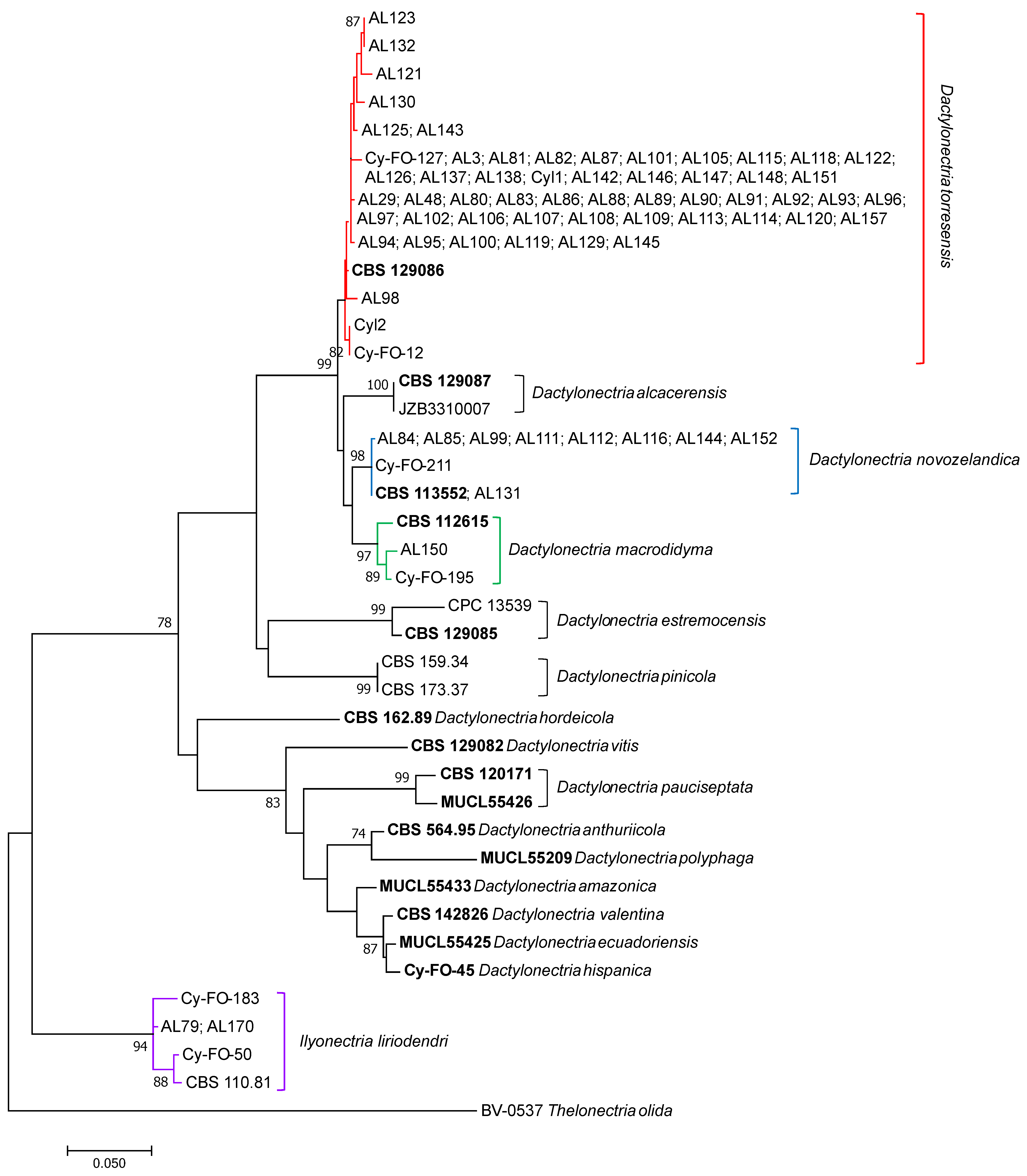
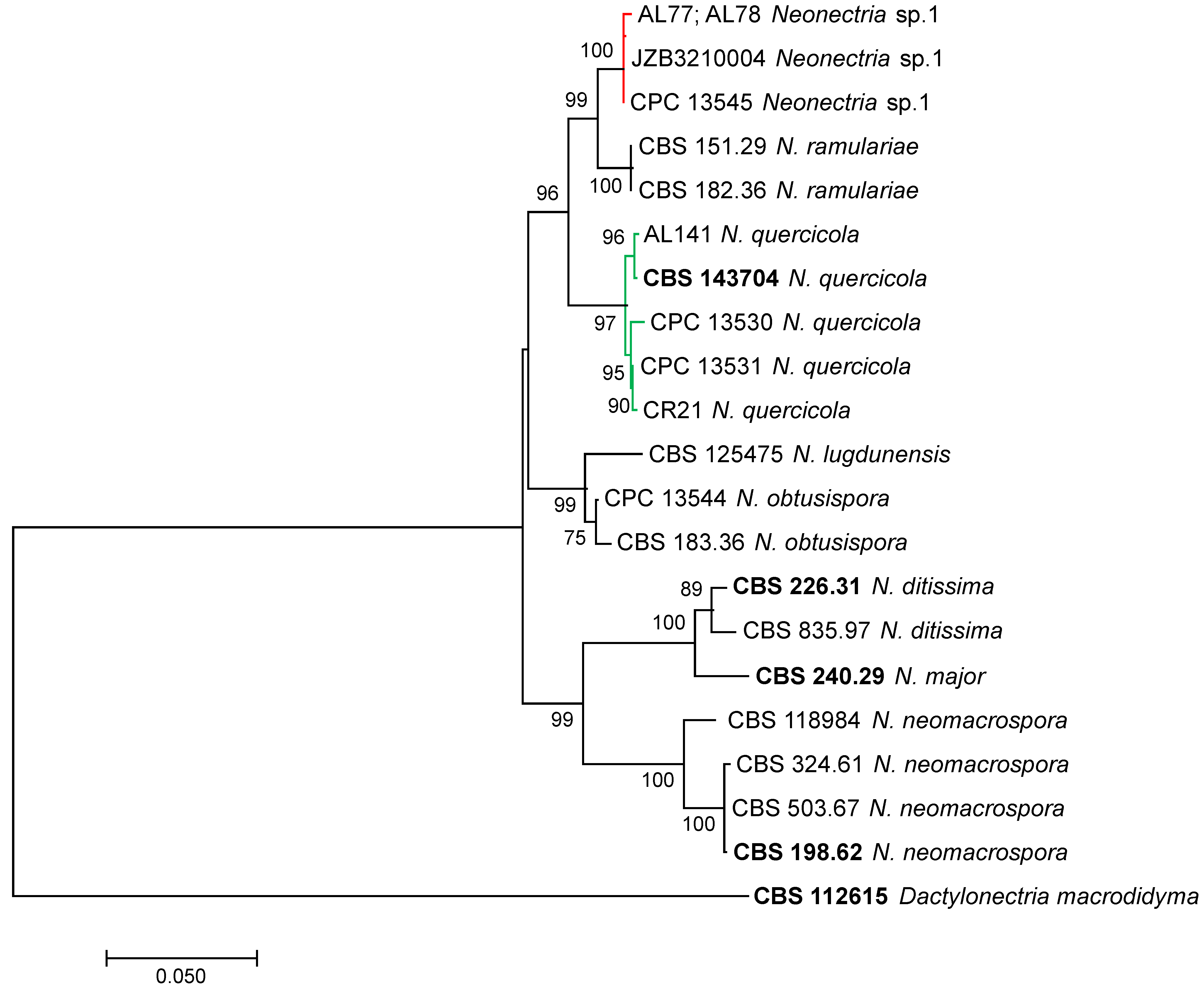
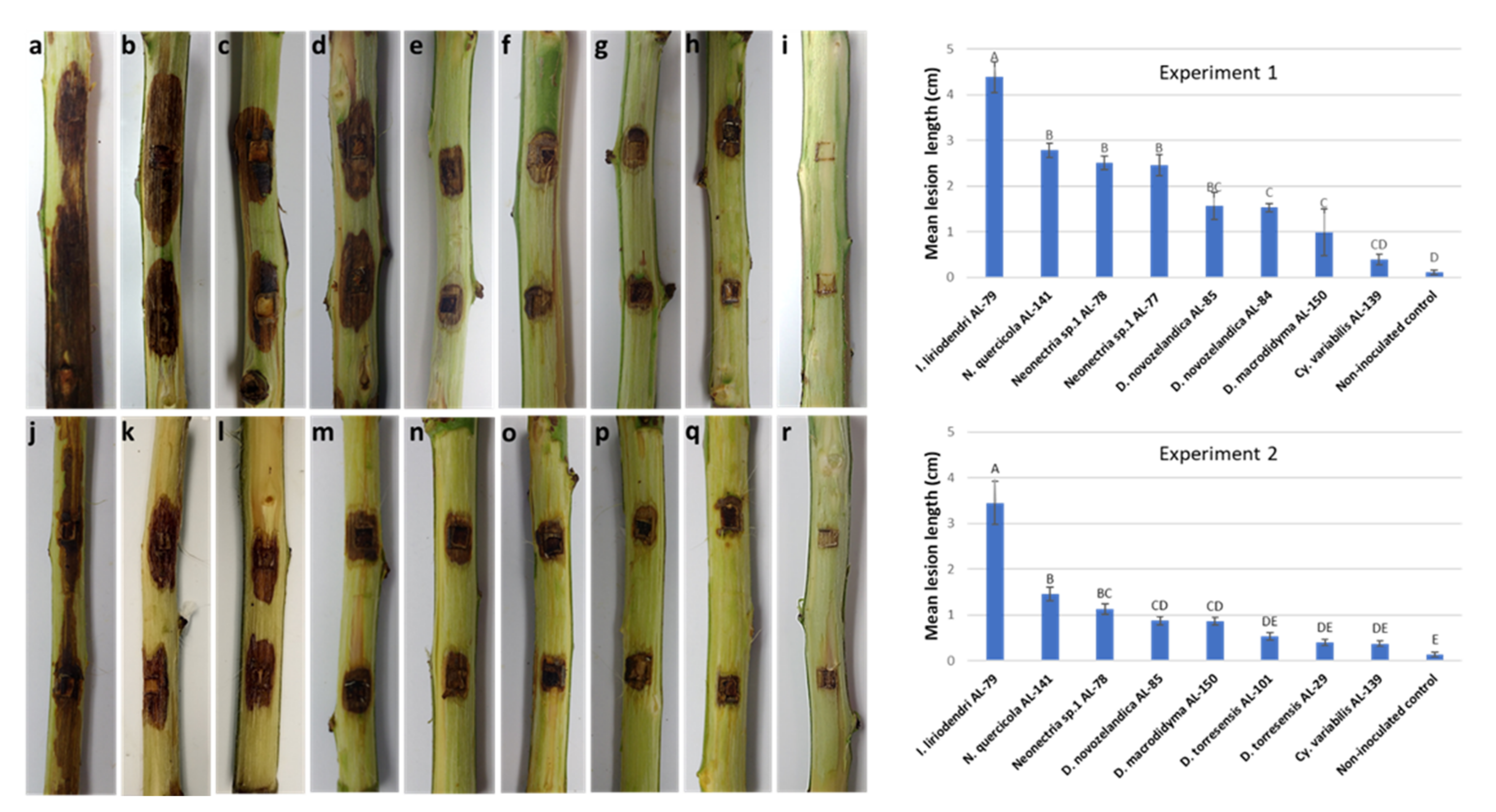
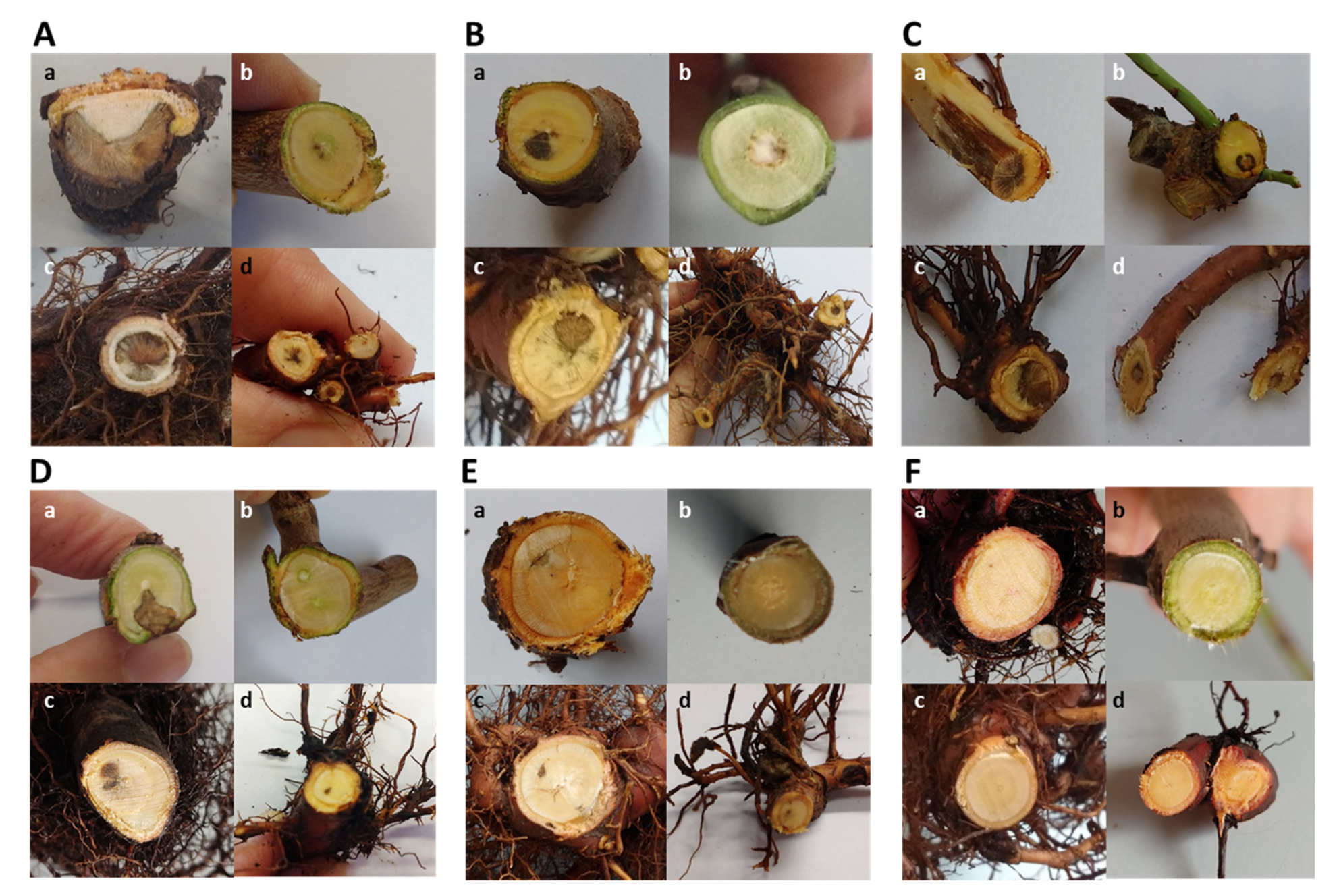

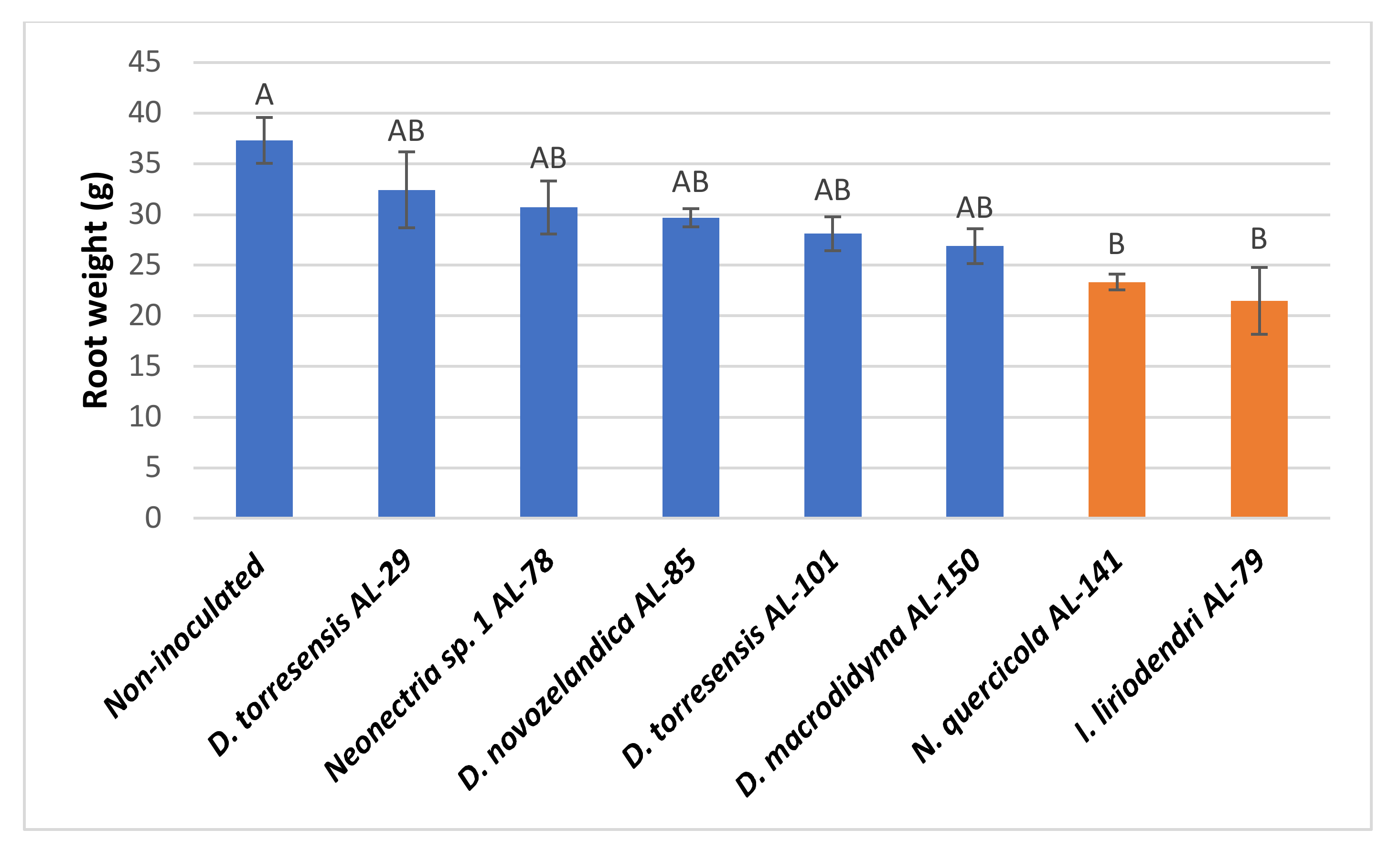
| Species | Isolate | Rootstock | Tissue of Origin | GenBank Accession No. | |||
|---|---|---|---|---|---|---|---|
| ITS | his3 | tub2 | tef1-α | ||||
| Dactylonectria torresensis | AL3 | GxN-15 | main root | OM514923 | OM483314 | - | - |
| AL29 | Rootpac-40 | main root | OM514924 | OM483315 | - | - | |
| AL48 | GxN-15 | feeder root | OM514925 | OM483316 | - | - | |
| AL80 | RP-R | feeder root | OM514926 | OM483317 | - | - | |
| AL81 | RP-R | basal trunk | OM514927 | OM483318 | - | - | |
| AL82 | GxN-15 | main root | OM514928 | OM483319 | - | - | |
| AL83 | GxN-15 | main root | OM514929 | OM483320 | - | - | |
| AL86 | GxN-15 | main root | OM514930 | OM483321 | - | - | |
| AL87 | GxN-15 | main root | OM514931 | OM483322 | - | - | |
| AL88 | GxN-15 | main root | OM514932 | OM483323 | - | - | |
| AL89 | GxN-15 | feeder root | OM514933 | OM483324 | - | - | |
| AL90 | GxN-15 | feeder root | OM514934 | OM483325 | - | - | |
| AL91 | GxN-15 | main root | OM514935 | OM483326 | - | - | |
| AL92 | GxN-15 | main root | OM514936 | OM483327 | - | - | |
| AL93 | GxN-15 | main root | OM514937 | OM483328 | - | - | |
| AL94 | GxN-15 | main root | OM514938 | OM483329 | - | - | |
| AL95 | GxN-15 | main root | OM514939 | OM483330 | - | - | |
| AL96 | GxN-15 | main root | OM514940 | OM483331 | - | - | |
| AL97 | GxN-15 | main root | OM514941 | OM483332 | - | - | |
| AL98 | GxN-15 | main root | OM514942 | OM483333 | - | - | |
| AL100 | GxN-15 | basal trunk | OM514943 | OM483334 | - | - | |
| AL101 | GxN-15 | main root | OM514944 | OM483335 | - | - | |
| AL102 | GxN-15 | feeder root | OM514945 | OM483336 | - | - | |
| AL105 | GxN-15 | main root | OM514946 | OM483337 | - | - | |
| AL106 | GxN-15 | main root | OM514947 | OM483338 | - | - | |
| AL107 | Nemaguard | main root | OM514948 | OM483339 | - | - | |
| AL108 | GxN-15 | main root | OM514949 | OM483340 | - | - | |
| AL109 | RP-R | feeder root | - | OM483341 | - | - | |
| AL113 | Rootpac-40 | feeder root | - | OM483342 | - | - | |
| AL114 | Rootpac-40 | feeder root | - | OM483343 | - | - | |
| AL115 | Rootpac-40 | feeder root | - | OM483344 | - | - | |
| AL118 | Rootpac-40 | feeder root | - | OM483345 | - | - | |
| AL119 | Rootpac-40 | feeder root | - | OM483346 | - | - | |
| AL120 | Rootpac-40 | feeder root | - | OM483347 | - | - | |
| AL121 | Rootpac-40 | feeder root | - | OM483348 | - | - | |
| AL122 | Rootpac-R | main root | - | OM483349 | - | - | |
| AL123 | Rootpac-R | main root | - | OM483350 | - | - | |
| AL125 | GxN-15 | feeder root | - | OM483351 | - | - | |
| AL126 | GxN-15 | feeder root | - | OM483352 | - | - | |
| AL129 | GxN-15 | main root | - | OM483353 | - | - | |
| AL130 | GxN-15 | main root | - | OM483354 | - | - | |
| AL132 | GxN-15 | main root | - | OM483355 | - | - | |
| AL137 | Rootpac-40 | main root | - | OM483356 | - | - | |
| AL138 | Rootpac-40 | feeder root | - | OM483357 | - | - | |
| AL142 | GxN-15 | feeder root | - | OM483358 | - | - | |
| AL143 | GxN-15 | main root | - | OM483359 | - | - | |
| AL145 | GxN-15 | main root | - | OM483360 | - | - | |
| AL146 | GxN-15 | main root | - | OM483361 | - | - | |
| AL147 | GxN-15 | main root | - | OM483362 | - | - | |
| AL148 | GxN-15 | main root | - | OM483363 | - | - | |
| AL151 | GxN-15 | feeder root | - | OM483364 | - | - | |
| AL157 | Rootpac-R | main root | - | OM483365 | - | - | |
| Cyl1 | - | main root | OM514950 | OM483366 | - | - | |
| Cyl2 | - | main root | OM514951 | OM483367 | - | - | |
| D. novozelandica | AL84 | GxN-15 | feeder root | - | OM483368 | - | - |
| AL85 | GxN-15 | main root | - | OM483369 | - | - | |
| AL99 | GxN-15 | feeder root | - | OM483370 | - | - | |
| AL111 | Rootpac-40 | feeder root | - | OM483371 | - | - | |
| AL112 | Rootpac-40 | feeder root | - | OM483372 | - | - | |
| AL116 | Rootpac-40 | main root | - | OM483373 | - | - | |
| AL131 | GxN-15 | feeder root | - | OM483374 | - | - | |
| AL144 | GxN-15 | feeder root | - | OM483375 | - | - | |
| AL152 | Rootpac-R | main root | - | OM483376 | - | - | |
| D. macrodidyma | AL150 | GxN-15 | main root | - | OM483377 | - | - |
| Ilyonectria liriodendri | AL79 | Nemaguard | main root | - | OM483378 | - | - |
| AL170 | GxN-15 | main root | - | OM483379 | - | - | |
| Neonectria sp. 1 | AL77 | Nemaguard | main root | OM514952 | OM483380 | OM483386 | - |
| AL78 | Nemaguard | main root | OM514953 | OM483381 | OM483387 | OM483384 | |
| Neonectria quercicola | AL141 | Rootpac-40 | main root | OM514954 | OM483382 | OM483388 | OM483385 |
| Cylindrocladiella variabilis | AL139 | Rootpac-40 | feeder root | - | OM483383 | - | - |
Publisher’s Note: MDPI stays neutral with regard to jurisdictional claims in published maps and institutional affiliations. |
© 2022 by the authors. Licensee MDPI, Basel, Switzerland. This article is an open access article distributed under the terms and conditions of the Creative Commons Attribution (CC BY) license (https://creativecommons.org/licenses/by/4.0/).
Share and Cite
Capote, N.; Del Río, M.Á.; Herencia, J.F.; Arroyo, F.T. Molecular and Pathogenic Characterization of Cylindrocarpon-like Anamorphs Causing Root and Basal Rot of Almonds. Plants 2022, 11, 984. https://doi.org/10.3390/plants11070984
Capote N, Del Río MÁ, Herencia JF, Arroyo FT. Molecular and Pathogenic Characterization of Cylindrocarpon-like Anamorphs Causing Root and Basal Rot of Almonds. Plants. 2022; 11(7):984. https://doi.org/10.3390/plants11070984
Chicago/Turabian StyleCapote, Nieves, María Ángeles Del Río, Juan Francisco Herencia, and Francisco Teodoro Arroyo. 2022. "Molecular and Pathogenic Characterization of Cylindrocarpon-like Anamorphs Causing Root and Basal Rot of Almonds" Plants 11, no. 7: 984. https://doi.org/10.3390/plants11070984
APA StyleCapote, N., Del Río, M. Á., Herencia, J. F., & Arroyo, F. T. (2022). Molecular and Pathogenic Characterization of Cylindrocarpon-like Anamorphs Causing Root and Basal Rot of Almonds. Plants, 11(7), 984. https://doi.org/10.3390/plants11070984






